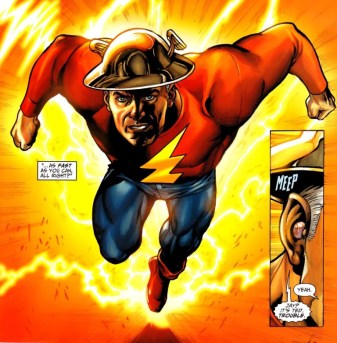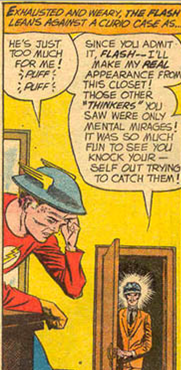 September
16
September
16
Tags
Diametrically Opposed: Golden Age Flash / The Thinker
Diametrically Opposed is a series exploring the best hero-villain rivalries in the DC Universe.
Seventy-five years ago, the Flash made his comic book debut, long before Barry Allen ever became the Scarlet Speedster. Also known as the Man of Speed, Jay Garrick was the Golden Age Flash – the precursor to a long lineage of speedster superheroes. And in All-Flash #12 just a few years later, he would first encounter the supervillain that would become his greatest archenemy, the mental juggernaut known as the Thinker.
The Flash (Jay Garrick)
A student at Midwestern University in Keystone City, Jay Garrick was a student of physics and chemistry as well as a star football player. One night, while conducting an experiment of radioactive “hard water”, Jay accidentally knocked over the entire experiment, inhaling the deadly fumes and falling unconscious. When he eventually came to, he discovered that the mysterious vapour had granted him incredible super-speed, and though he initially used the speed for small gains on the football field, an attempt to kill his sweetheart Joan Williams propelled him to become a superhero. Calling himself the Flash, he became the superpowered protector of Keystone City, and following the events of Crisis on Infinite Earths, he became the predecessor and mentor to Barry Allen, the Silver Age Flash.Much like other incarnations of the Flash, Jay Garrick’s super-speed is not only his primary superpower, but also a gateway to a number of other abilities, including phasing and vortex generation. Post-Crisis, Jay’s speed was augmented by the Speed Force, through which he was able to steal and gift speed to other speedsters. His speed is also a primary reason behind his reduced aging and enhanced healing ability. Post-Flashpoint, Jay has many of these same abilities, but they are derived from the magic of Mercury – the last Olympian god of Earth 2.
As the original Flash, Jay Garrick was a charter member of both the Justice Society of America and the All-Star Squadron, as well as being a member of the Justice League.
The Thinker
Before becoming a supervillain, Clifford DeVoe worked as a lawyer in Keystone City as well as the corrupt and crime-ridden Gotham City. After refusing to grill a female witness, he lost a case against a major Keystone City crime boss and was forced to quit as a lawyer. With this failure symbolizing the proof that crime could pay, a disillusioned DeVoe realized that the reason so many criminals ended up behind bars was because for all their skills, they lacked the intelligence to properly plan out their crimes. Calling himself the Thinker, he began to work for the same crime boss he failed to put away, using his intelligence and planning, as well as his knowledge of the legal system, in order to assist in criminal activities. After being double-crossed, DeVoe planned out the “suicide” of his former employer, becoming the new crime lord of Keystone City and bringing him into direct conflict with the Flash.Not in possession of any superpowers, the Thinker’s genius-level intellect and legal expertise were originally his only abilities. But after his initial defeat at the hands of the Flash, the Thinker was able to augment his mental prowess when he came into possession of the Thinking Cap – his iconic headgear that allowed him to amplify his own mental abilities, project mental force in physical space, and granted him limited telekinesis and mind-control. Long after his death, his residual brainwaves within the Thinking Cap brought him back as a holographic artificial intelligence, which allowed him to hack and control any digital technology.
In addition to his frequent clashes with the Flash, The Thinker took on the Justice Society of America as a member of both the original Injustice Society on Earth-Two (pre-Crisis) as well as the modern, New Earth incarnation of the group (post-Crisis). He was also briefly a member of Amanda Waller’s Suicide Squad.
VS.
As with several hero-villain rivalries, the rather obvious first level on which these two are opposed seems to be that of body and mind, with the Flash’s physical kinetic power representing the former, and the Thinker’s mental power representing the latter. The most notable similar rivalry would be that of Superman and Lex Luthor; in fact, theirs is a much clearer demonstration of brawn vs. brains than the rivalry in question. In the case of the Golden Age Flash and the Thinker, that line is rather blurry. Jay Garrick can use his tremendous speed to quicken his thinking, making his brain process information at an accelerated rate. Likewise, the Thinker uses his Thinking Cap to manifest his thought-power physically through telekinesis and physical bolts of mental energy.
Perhaps, then, while acknowledging the obvious body/brain dynamic at play, the real source of opposition lies in how those physical and mental powers affect them.It is important to note that in spite of gaining a number of abilities, Jay Garrick’s powers do not, in an intrinsic sense, change him. He doesn’t have bigger or stronger legs, nor does he become more aerodynamic. Quite simply, he is able to move at super-speed. This extends to his use of speed to quicken his thoughts. While he is certainly able to think more quickly and process information at a greater rate, this does not make him any more innately intelligent. Of course, he can learn new things at a greater rate, but his speed does not inherently make him any more able to comprehend that which he is learning. Things he is unable to understand are not suddenly unlocked to him, he is merely able to scan through that incomprehensible information much more quickly. By contrast, in donning the Thinking Cap, the Thinker’s mental acuity is actually increased. It boosts his ability to think, not simply the speed at which he thinks. This is a most fundamental kind of change; our brains are who we are, so any change in the function and capacity of our brains is therefore a change in who we are as people.
This relationship between powers and change manifests even more clearly in the ultimate toll it takes on each of them. For Jay, his super-speed is a primary factor in his decelerated aging. Post-Crisis, when the continuities of Earth-Two and Earth-One were merged into a single history, Jay was an active superhero during World War II, and yet remained active decades later, having aged at a fraction of the pace of his non-powered peers. For the Thinker, the extended use of his Thinking Cap took an intense physical toll on his body resulting in terminal cancer.
After his death, the Thinking Cap passed to Cliff Carmichael, a rival of Ronnie Raymond (one of the components of Firestorm). Carmichael became the second Thinker, but the Cap exacerbated his already tenuous mental state and drove him completely insane, solidifying the mythological legacy of the Thinker. Ultimately, what the mythology seems to suggest is that in attempting to change his inherent nature – and likely also due to his moral alignment – he became the cause of his own undoing. This should come as little surprise given how entrenched the notion of inherency is to the entire DC Universe. And while the Thinker effectively took himself out of the equation, Jay’s steadfastness was rewarded with one of the richest heroic legacies in all of comics, inspiring and mentoring multiple generations of Flashes.Perhaps only matched by that of the Green Lantern and Solomon Grundy, the rivalry between the Flash and the Thinker is one of the most lasting and important of the Golden Age, rooted in one of the fundamental principles of the entire mythology.





